
NORTHERN BUGEY
Just southeast of Bourg-en-Bresse, the Autoroute des Titans (‘the Titans’ Highway’, so named by France’s late president François Mitterrand because of the massive supports required to allow the motorway to pass across the gorges and valleys between the mountain tunnels) runs right through northern Bugey. Along it drive trucks and tourists’ cars heading to Italy via the Mont Blanc tunnel or to the Alpine ski areas, oblivious, as I was for many years, that there are vineyards directly below. Before Mitterrand opened the section in 1989, the main Lyon–Geneva road passed through the Cerdon vineyard area, which benefited from those stopping to pause at a local restaurant and stock up with wines. Now the Cerdon area has become another of those sleepy, albeit beautiful, French backwaters. Outside summer there are few places to eat or to stay and apart from at the largest wine producer, Lingot-Martin, based on the main road through Poncin, you’d better make sure you have an appointment for a tasting.
The small town of Poncin serves as the district’s administrative centre. Most of Poncin’s vineyards are south of the motorway, stretching east towards St-Alban, and to the north there are also some at La Cueille. Cerdon itself is a quiet village full of interesting buildings, alleyways and fountains, and once had an important copper factory, which doubled as a museum. In 2017 Ain’s tourism organization took over the buildings, which had lain dormant for some years, with a view to re-opening a visitor centre. Viewed from the hills above, Cerdon is fascinating, lying in a reculée or blind valley, one of the classic features of Jura mountain geology; the village is dominated by its steep, south-southeast-facing calcareous vineyard slope, called La Grande Côte (the big hillside). Between the vineyards, a few of them still terraced, are crumbling stone walls, grangeons and little celliers (vineyard huts).
Head up the hill just a few kilometres from Cerdon to the even quieter vineyard village of Mérignat to arrive in another world, almost in the woodlands, with vineyards reaching up to 500m altitude and views towards Beaujolais, 60km to the west, and in the other direction towards the Alps. Home to three of the producers profiled in this section, Mérignat has almost reached the status of organic-only vineyards, contrasting with Cerdon itself, where most growers find it easier to use herbicide. From Mérignat you can meander south to Jujurieux, which boasts 13 châteaux, dating from the Middle Ages to the 19th century, as well as the old Bonnet silk factory, now a museum. Between here and Boyeux-St-Jérôme the landscape is one of abrupt Jurassic cliffs with green pastures below, small hamlets and vineyards in between.
Geologically speaking – and visually – this part of Bugey is an extension of the Revermont area of southern Jura and this is most noticeable in the less-planted sector of scattered vineyards northwest of Poncin around St-Martin-du-Mont, Journans and the group of villages named Bohas-Meyriat-Rignat. Indeed, the southernmost Jura AOC vineyards in St-Amour are only about 30km to the north. Around the hamlets of Soblay and Gravelles, near St-Martin-du-Mont, the vineyard slopes have more marl than limestone, particularly suited to Poulsard.
There are many very small vignerons here (not all profiled) and due to the technical challenges and expense of the ancestral method, the Cerdon district has several CUMAs – agricultural co-operatives that allow growers here to share the expensive equipment needed for bottling and for the transfer to remove the sediment and re-bottle. One of the first was set up in the early 1970s in Mérignat by Philippe Balivet, who was soon joined by Raphaël Bartucci and Patrick Bottex (from La Cueille) among others. This CUMA uses the direct bottle-to-bottle transfer system and regularly updates its equipment. Today it is able to process 6,000 bottles a day with three people working the line, whereas the previous line managed only 1,000 bottles a day with seven people working.
The main wines to expect
Producers offer one or more cuvées of Bugey Cerdon, the sweetish pink sparkling wine made by the Méthode Ancestrale from Gamay with occasionally Poulsard. Some may also offer Bugey Brut and Bugey AOC still wines too, mainly from Chardonnay. There are also cheaper carbonated sparkling wines made.
Véronique Antoine
The story of Véronique Antoine provides a lovely example of the many tiny producers within the Bugey Cerdon AOC. Originally from Belfort in Franche-Comté, with no family connections with the world of wine, in her mid-thirties and mother of three children, Véronique was keen to change from office life to work in the open air. She decided to retrain to be a vigneron, and after studies in Belley and Mâcon, she and her husband, an electrician from nearby Bourg-en-Bresse, settled in an old house with a cellar in the small village of Rignat. Little by little Véronique bought and rented small plots of old vines, making wine from some, pulling up and replanting others to build up to her current (still tiny) vineyard area. She gained a local reputation for her wines and in 2015, on the site of one of her vineyards on the edge of Rignat, the couple built a new house with a purpose-built cellar, including a tasting room. In 2017 she sought official certification for organic conversion.
While waiting for the Gamay and Poulsard vines she planted in 2006 in the Cerdon AOC zone to become productive, Véronique’s first sparkling wines were made using the ancestral method from grapes grown in old vineyards situated outside the AOC and sold as Vin de France Pétillant. Her main Cerdon plot is on a very stony clay-limestone slope, exposed east, not as steep as Cerdon itself and going up to 400m altitude. She chose to plant still wine clones rather than those usually destined for sparkling wines in order to give smaller yields; she retains the natural vegetation between the vine rows and farms entirely organically, benefiting from some friendly advice from Raphaël Bartucci. Working organically has made it easy to sell direct from the cellar door and at local markets and she has exported to Japan.
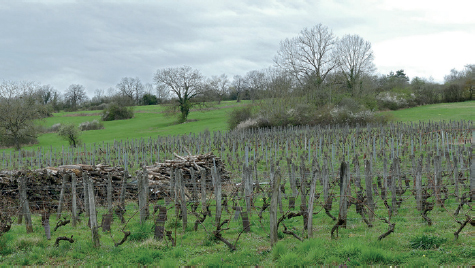
Véronique Antoine’s rural and remote vineyard is now run organically.
After crushing, the red grapes macerate for a while in her old Vaslin press and are then fermented in old milk tanks. She uses her local CUMA for the transfer and a mobile bottling service. Véronique’s first Bugey Cerdon AOC was from 2009 and in a typical year she makes about 5,000 bottles plus 500 half bottles. It is a really strawberry-like Cerdon, not very sweet, with maximum 30g/l of residual sugar.
In years when the badgers don’t take the grapes, as they did in 2016, Véronique makes an ancestral method sparkling Jacquère, and her one still wine is a simple, minerally Bugey AOC Chardonnay, first produced in 2015. Véronique wants to keep her estate small and it is obvious she loves the work of a vigneron from A to Z; she is one of Cerdon’s most active online marketers.
Véronique Antoine
281 En Reculet, Rignat, 01250 Bohas-Meyriat-Rignat
Tel: 04 74 51 85 13/06 67 13 00 86
Email: vinpetillant.veroniqueantoine@gmail.com
Web: cerdon-antoine.fr
Map ref: A3
Vineyards: 2.6ha
Certification: Qualisud
Visits: Tasting room, preferably by appointment
Domaine Philippe Balivet
Louis Balivet, a mixed farmer, would leave one barrel of his red wine, made from hybrids, outside over winter. He knew the yeast would keep working despite the cold and also that, with luck, at some point fermentation would stop to leave a slightly fizzy sweet wine, balancing the naturally high acidity. His son, Philippe Balivet, founded the wine estate in 1967 and was for several years the mayor of Mérignat. He was instrumental in establishing the important CUMA in the village and installed his first refrigeration unit in 1991.
Philippe believed that the availability of Cerdon wine would encourage people to stop en route between Lyon and Geneva. He wasn’t a great salesman, his children claim, but word gets around and today nearly a quarter of their 25,000-bottle production is exported without them ever going out to sell. Now in his mid-seventies, Philippe continues to help in the vineyards, which are located mostly in Mérignat. The vineyards are steep and he originally planted them with relatively wide spacing to make them easy to plough using a small tracked vehicle rather than the popular, but relatively unstable, tractor that straddles the vines. Philippe became unwell in the early 1980s and the family believed it was due to a chemical fungicide – this was the trigger to convert the vineyards to organics in 1984. Philippe doesn’t make a big deal about making organic wine; he simply says it protects the soil. Those wide-spaced vines are easier to weed today with an intercep rather than by hand with a hoe and they have never specifically planted grass. ‘It just grows, so why plant it?,’ says Vincent, ‘It’s not a golf course…’
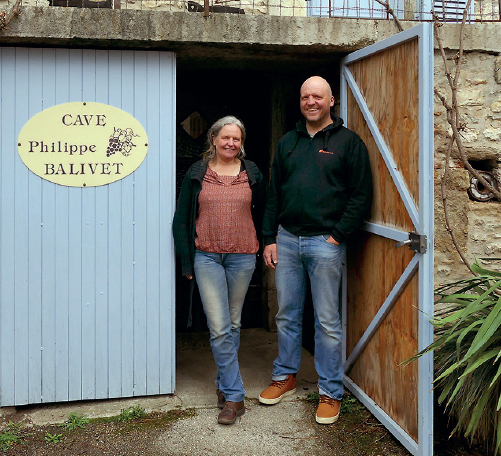
Cécile and Vincent Balivet in Mérignat.
The estate is now run by Philippe’s children, Cécile and her younger brother Vincent, and it’s obvious they both love the job. Cécile had been a care-worker and done some gardening courses, but her father encouraged her to come to work with him and she learned on the job. Vincent originally toyed with studying music – like his father he plays in a local band; he is also married to a music teacher and orchestra leader. Before committing to working in wine he also considered archaeology, or even becoming a coroner… but wine studies seemed easier and the courses at Beaune inspired him to continue.
The small cellar is Vincent’s domain and you can tell from a glimpse at his detailed notebook that he is fastidious – he even does his own analysis, a rare thing today. Since the big vintage of 2011 he has held some wine back and blended vintages for their main cuvée, which is 100% Gamay with about 55g/l of residual sugar – it’s a lovely Cerdon, with very good length. A second cuvée, named Récolte Cécile, is from a varying blend of Gamay and Poulsard – it’s technically sweeter, but doesn’t seem it. Since 2014, Vincent has also, rather reluctantly, made a small amount of a cuvée named La Dernière with no added sulphur, made from Gamay planted in the 1970s in their highest vineyard at 457m. ‘People seem to like it,’ says Vincent.
This is a close-knit family. Cécile’s partner does the computer work for the estate and their children occasionally work with them in the vineyards. For Vincent, his involvement in music is equally important, to maintain a balanced outlook. Cécile and Vincent describe their father as a visionary, and former Bugey syndicate technician and historian Claude Paul would not disagree. He told me that by establishing the CUMA Philippe brought local vignerons together and helped to popularize Cerdon wine. Undoubtedly this thoughtful family’s early commitment to organics is also important to Mérignat and the Cerdon appellation. Every sip of their wines seems to tell a story.
Domaine Philippe Balivet
12 Rue de la Balmette, 01450 Mérignat
Tel: 04 74 39 98 26
Email: gaec-balivet@orange.fr
Contact: Cécile or Vincent Balivet
Map ref: C2
Vineyards: 7ha (including 10% Poulsard)
Certification: Ecocert
Visits: Preferably by appointment
Raphaël Bartucci
Meet Raphaël Bartucci: born of Italian immigrants, he was brought up in the Moselle region in eastern France. He collects fossils from the vineyards and displays them museum-style in the cosy tasting room below his house. Cerdon was the first wine he actually enjoyed drinking, but now he revels in good organic wines from everywhere; other vignerons in Cerdon think he is an extra-terrestrial, or so he claims. Often it takes an outsider to shake up a sleepy region, and with a twinkle in his eye Raphaël is pretty sure he did just that.
After training as an electrician, Raphaël decided he wanted to live in the countryside away from the Moselle. He had discovered Bugey while travelling through on holidays, and loved the wildness and beauty of the Cerdon area. He did a harvest with Philippe Balivet, who helped him find an old house for sale in 1981 – it included cellars of course, with barrels and a press. While continuing to work full-time as an electrician until 1991, Raphaël began buying small plots of vineyards and making wine for himself. In 1983 he started commercializing his wine, with 1,500 bottles from just 0.15ha of vines. The next vintage, 1984, was so poor (the last year he chaptalized, incidentally) he could make only 800 bottles, despite owning double the vineyard area. Locals regularly offered him plots of vines to buy or rent, which no one else wanted as they were too hard to work – each year he took on another 0.1 to 0.15ha. Today Raphaël owns all his vineyards and until recently he still worked ten hours a week for the village council.

In his tiny tasting room, Raphaël Bartucci displays his collection of fossils, found in his vineyards.
In 1985 he visited the legendary Jura vigneron Pierre Overnoy and later met Marcel Lapierre of Beaujolais. It was just the time when Pierre and Marcel were adopting the methods inspired by Jules Chauvet. Pierre stressed to Raphaël the importance of farming his land without chemicals to protect the natural yeasts. Raphaël was easily convinced to farm organically – this is ‘agriculture simple’, he tells me. He ploughs the soil and sprays with copper and sulphur, along with horsetail and black soap as extra anti-fungicides. Certified organic since 1997, he seems quietly pleased that at last he’s accepted in the region and that others around him are finally adopting environmental measures and turning to organics.
He planted Poulsard in 1986 and 1990 on the soils with more marl and crinoid fossils, and in 2015 he planted a little more, using mass selections from the older vines. The proportion of Poulsard in his Cerdon varies from 15 to 20% and he says it brings an elegance and extra complexity to the Gamay. He also has a little Chardonnay, planted in 1989, and it used to be part of his Cerdon blend. But it was outlawed by the 2009 AOC rules and now he makes about 200 bottles of white wine mainly for himself and his 25–30 harvesters. Raphaël likes to pick his Gamay and Poulsard as late as possible. He aims for a potential alcohol of 11%, uses whole bunch pressing and does not macerate the grapes at all. Part of the local CUMA, he starts bottling in early November when the alcohol reaches 6% and then allows two to three months for the ongoing fermentation and time on the lees, with the first batch of wine available in early January. Everything is transferred and sold by the end of March.
Technically Raphaël Bartucci has now retired, and his estate exists under the official name of Eliane Zivkovic, who just happens to be his wife, a full-time teacher. They have one employee, Laetitia, but nothing has really changed over the years and Raphaël works as hard as ever in his close-spaced vineyards, finding more fossils, preserving his terroir to protect the yeast population and ‘making sure his Cerdon won’t poison anyone’.
If you are lucky enough to track this wine down, you may well find it to be the most moreish Cerdon you’ll ever taste. For a rosé that is pressed directly, it is surprisingly deep-coloured. A touch closed to begin with, it slowly reveals tangy apples and pears from the Poulsard and that strawberry red fruit from the Gamay. It doesn’t hide its sweetness, but has fine acidity and great length, with a hint of grapefruit. The one problem is that the annual production of 13,000–15,000 bottles of Raphaël Bartucci’s Cerdon disappears much too quickly into the cars of faithful customers who make the pilgrimage each year to buy from the cellar door, and to long-term trade customers in France, the US, Canada, Japan and beyond. Long may he continue to make them.
Raphaël Bartucci
Chemin du Paradis, 01450 Mérignat
Tel: 04 74 39 95 94
Email: raphael.bartucci@libertysurf.fr
Map ref: C2
Vineyards: 2.1ha
Certification: Ecocert
Visits: Tasting room, preferably by appointment
Patrick Bottex
California-based wine merchant Kermit Lynch has imported Cerdon from Patrick Bottex for over a quarter of a century. Always ahead of the game, Kermit discovered Cerdon by chance, not long after Patrick and his wife Catherine had established the estate. Now 40% of Patrick’s small production is exported to the US, Canada, Japan and Taiwan; the rest is sold direct to consumers in France, mainly from the cellar door.
The Bottex family live and farm most of their vineyards in a hamlet that you would never discover without a reason to do so. La Cueille, located on a hillside upriver from the town of Poncin, has an impressive fortified castle with the renovated St-Antoine chapel next to it. Above it is a newly planted vineyard, named Clos du Château, which should one day be the pride and joy of Patrick, Catherine and their son Carl. In 2015 they were able to buy the land and started clearing the 60% slope and have initially planted 0.5ha of vines – the last harvest from vines in the Clos was sometime around the Second World War. The hillsides in La Cueille once had about 100ha of vineyards. Today pine forests prevail, with a few patches of steep vineyards here and there, most of which belong to the Bottex family, including one single plot of 3.5ha.
Patrick’s maternal grandfather, Marius Callerin, had been a mixed farmer with some vines in La Cueille, but Patrick was brought up in the city of Lyon. Patrick wanted to be a farmer and studied agronomy, but with the family holdings being very small it was hard to make a start. At the end of the 1980s a large parcel of land in La Cueille was reclassified as part of the Cerdon appellation (then VDQS) so, seizing the opportunity, in 1991 Patrick and Catherine took on some of the land to plant, as well as two nearby plots of old vines (0.7ha in total).
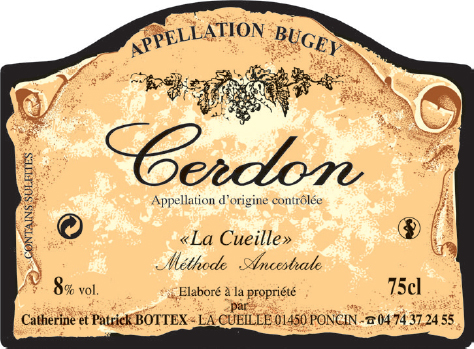
Patrick works his vineyards in a sustainable way, believing in the importance of working the soil, grassing down to avoid erosion and restricting the herbicide to below the vine rows. Although the Ain river is just below the vineyards, humidity presents little problem; along with sulphur, the least toxic systemic chemical sprays are used. Spending time with Patrick, it becomes obvious that for him the essential work is in the vineyard, right up to harvest, which is all manual. Their vines are mainly Gamay, with a little Pinot Noir for red wine, mainly for home consumption, and a few vines of Poulsard; as the Poulsard vines die, Patrick does not replant them as he finds the variety too difficult.
You can tell from the purply pink colour of the wine that Patrick uses some maceration time before pressing the Gamay. He also keeps the bottles upright for the second part of fermentation in the traditional way. He belongs to the Mérignat-based CUMA and chooses to do regular transfer operations, enabling him to supply Kermit Lynch’s US distributors directly in small lots. Patrick is candid and notes that it is never an exact science how much sugar you end up with, but he aims for 50–60g/l in the final wine. The wonderfully old-fashioned Bottex label seems a throwback to a time long before this ancestral method was perfected – but it serves the family well.
Patrick Bottex
La Cueille, 01450 Poncin
Tel: 04 74 37 24 55/06 81 83 41 57
Email: patrick.bottex@wanadoo.fr
Web: cerdon-bottex.pagesperso-orange.fr
Contact: Catherine or Patrick Bottex
Map ref: C3
Vineyards: 6.5ha
Visits: Tasting room, welcomed by appointment
La Combe aux Rêves
Grégoire Perron loves Poulsard and his early reputation was established by his pink sparkling wine, made in the ancestral method. He does not make Cerdon, instead labelling all his wines Vin de France, preferring the freedom from rules, paperwork and costs associated with the AOC label. La Combe aux Rêves (which means ‘the valley of dreams’) Noct’en Bulles, a pink sparkling wine blend, is today made as a Pétillant Naturel, without the process of removing the yeasts. Part of the blend is from some of the oldest Poulsard vines in the area. Grégoire, who worked for a while at Domaine Pavelot in Burgundy, describes the Gravelles slope on the Croix de la Dent hill as the ‘Corton of Bugey’. It reflects his respect for the terroir here as well as the visual evidence: like Corton, these vineyards seem to wear a forested headdress over a wide skirt of vineyards. It was this ancient plot of vines that encouraged him to establish his winery nearby.
Brought up near Lyon, Grégoire wanted to work outdoors and after trying forestry discovered the world of wine. He studied in Bordeaux and Mâcon and trained with Jean-François Ganevat in the Jura, followed by over a decade of experience with large wineries in France, the US and New Zealand. He had always wanted to work organically and with Ganevat and Domaine Pavelot he experienced it first-hand. In 2009 Grégoire and his partner Judicaëlle (Judy for short), who originally worked in computer graphics, settled in the quiet village of Journans, in a rambling old house with wine cellars below and a big courtyard, ideal for their two children, a Boxer dog called Houblon (French for ‘hops’, as in beer), vans and vineyard kit.
Now that Judy is working with Grégoire, they want to build up to 3.5ha of vineyards. Their vineyards are farmed organically, allowing natural vegetation to grow, which they control with a flock of rare-breed sheep. The sheep spend about a month in each plot between November and March, when they can do no harm to the vines, and then, in spring and summer, the grass is mown or ploughed back into the earth. Grégoire uses various plant applications – inspired by biodynamic methods – and algae to help prevent the copper and sulphur sprays being washed off the vines by rain.

Grégoire Perron in what he calls his ‘forest’ of old Poulsard vines.
The old-vine plots are mainly red, so Grégoire has cleared an abandoned plot in Journans to plant with mass selections of Savagnin, Altesse and a small amount of Chardonnay. Like most Journans vineyards the soil is clay-limestone; the Gravelles slope has older clay-rich marl or, in some parts, heavy red clay. On this red clay lies one of his older vineyards of co-planted Gamay, Pinot, Mondeuse and ‘many other varieties’ between 40 and 90 years old. The CAAPG has taken an interest and found that Grégoire had some almost extinct Gueuche Noire, from which cuttings have been collected. From here he makes his cuvée called Terre des Rangoux, co-fermenting all the varieties.
The old Poulsard vine forest (as Grégoire calls this erratic-growing 100–120-year-old vine plot) is on a part of Gravelles with grey marl, facing southeast. He has some Gamay here too and plans to plant Mondeuse, which was traditionally the most-planted variety on Gravelles. Grégoire uses some of the old-vine fruit for a red named L’Eveil du Loup (‘awakening of the wolf’), made from whole grape maceration in a big wooden vat, foot trodden, with a long vinification and ageing in demi-muid barrels.
All Grégoire’s wines are resolutely natural, with no added sulphur since 2013, but made with much thought. His whites are partly from bought-in grapes – in 2016 he helped out Luc Bauer, buying some of his Altesse and Chardonnay grapes to make a very Savoyard-style steely wine – but his own grapes are used for the fuller-bodied oak-fermented Terremère from about 70% Chardonnay with Altesse and Pinot Noir. Grégoire believes that wines with no added SO2 suffer a longer period of bottle shock (when wines taste unbalanced and/or inexpressive following bottling) and require at least six months resting before opening and then two to three years in bottle to be great. Even Noct’en Bulles and his other Pétillant Naturel sparkling wines take their time both to be vinified and to be ready to drink.
Grégoire makes his varied range in fibreglass tanks or old barrels (and most recently the demi-muids from Côte-Rôtie), but he would like to try out stoneware (rather than clay) ceramic containers too. Cuvées and ideas change each year here and Grégoire has a growing natural wine fan-base worldwide.
La Combe aux Rêves
227 Rue de l’Eglise, 01250 Journans
Tel: 06 16 51 54 90
Email: combeauxreves@orange.fr
Contact: Grégoire Perron
Map ref: A4
Vineyards: 2.5ha (+ some purchased fruit)
Certification: Natur et Progrès
Visits: Preferably by appointment
Domaine La Dentelle
Meeting with Marcel Perinet, it’s obvious right away that he is not an everyday vigneron. Despite knowing how to court the press, Marcel is modest and you have to hunt to find out his background. Forty years ago, he was crowned with one of the Best Sommelier awards in France – I say one, for that year there were three and his was for Maître d’Hôtel Sommellerie, wine service for a hotel restaurant. For 40 years Marcel was the right-hand man for Georges Blanc, a renowned chef and entrepreneur of the Lyon area, and he still lives in Vonnas, home to Georges Blanc’s top restaurant and gastronomic resort.
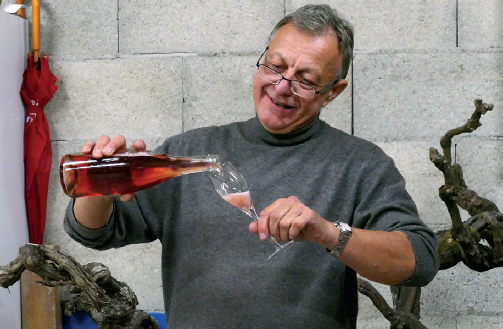
Making a Poulsard-dominated Cerdon is a late career for Marcel Perinet.
Marcel runs Domaine La Dentelle in Cerdon as a joint venture with his son Hubert, who inherited the property. Hubert lives in Paris and works in IT, but comes down to Cerdon for harvest and other key points in the winemaking calendar – but this is very much Marcel’s baby. The estate was named for the slope where the main vineyards lie – on the Croix de la Dent hill in the hamlet of Gravelles. Given the classic marl soils, ideal for Poulsard, this was the grape that Marcel decided to plant in 2010 and 2011 on the hillside, which ranges from 450–500m altitude. He has also taken over 1.5ha of old vineyards and purchases grapes from older growers in Gravelles. He hopes to end up with about 8ha, mainly Poulsard.
Noting that herbicide use caused the worst soil erosion, every other row is grassed down each year, with the alternate row ploughed using a small tracked vehicle, and then swapped over the next year. In 2017 Marcel started the official process of conversion to obtain organic certification. Harvest is by hand and he chooses the time specifically based on the grapes’ acidity levels. He aims for a final alcohol level of 8% and thinks that with the lower natural acidity resulting from climate change, he needs lower sugar levels.
Marcel has invested heavily in creating a tank room and buying bottling and transfer equipment so that the estate can be self-sufficient. He has a 20-hectolitre pressurized tank and with cooling equipment he can maintain this at 0°C. The line can handle the transfer of 3,000 bottles per day, which allows production to be spread through the year.
Domaine La Dentelle makes just one Cerdon cuvée, bottled in clear glass to show off the colour. In 2014, the first vintage, Marcel made about 7,000 bottles, which increased to 40,000 bottles in 2016, despite limiting yields. His Poulsard-dominant Cerdon reveals several differences from the Gamay-based wines, being paler and having a tendency to that animal, slightly reductive nose, along with a faint Alpine strawberry character; on the palate the 50g/l of residual sugar is in balance with the acidity, alcohol and gentle fizz, with delicate redcurrant flavours that lead to a much longer finish than many Cerdons. This is an easy-going drink, evidently made with love and joy. I hope that this new vigneron, the retiree Marcel, has many more vintages ahead of him and that his son Hubert continues with his legacy.
Domaine La Dentelle
65 Chemin du Péroux, 01160 St-Martin-du-Mont
Tel: 06 08 84 38 22
Email: marcelperinet@gmail.com
Contact: Marcel Perinet
Map ref: A4
Vineyards: 5.5ha (mainly Poulsard + occasional purchases)
Certification: Qualisud
Visits: Preferably by appointment
Cellier Lingot-Martin
Mr Lingot and Mr Martin no longer work at Lingot-Martin, Cerdon’s biggest wine company, but as so many who love the land, in their retirement you’ll still find them working in the vineyards. The Lingot, Martin and Bolliet families linked together in 1970 to make and market the wine from their 16ha of vines. Today there are four partners: brothers Jean-Luc and Frédéric Guillon, who joined the company in 2006, bringing 11ha of vines with them, Gilles Bolliet and Alexandre Vallet. They may co-operate on everything, but this is not a co-operative: it’s a partnership of families, with six further employees. With control of more than 20% of AOC Cerdon’s vineyards it’s gratifying to report that they seem to do a very decent job.
Lingot-Martin was the first Cerdon I ever came across, at one of the Vignerons Indépendents wine fairs in France. It was a light and refreshing change from all the Jura and Savoie wines I was assiduously tasting. And this was the first Cerdon cellar I visited, one cold winter’s day in 2009, in a bid to learn about the mysterious ancestral method first hand. On a more recent visit, they were preparing for their twice-annual open tasting weekend. The cellar is on the side of the main Lyon–Geneva road outside Poncin, next to the Monts et Terroirs cheese shop, with plenty of space for food stalls and parking. It was March, so the previous vintage was ready to show and hopefully sell to the world, or at least to the locals and visitors from the nearby cities of Bourg-en-Bresse and Lyon. About 55% of Lingot-Martin’s 35,000–40,000 bottles are sold direct to the consumer from the cellar door and from wine fairs around France, an important amount given the increased profit margin. A further 30% goes to supermarkets around the Rhône-Alpes region (including the ski areas) and just under 10% is exported, a figure Jean-Luc Guillon, who since 2018 has been president of the Bugey syndicate, would like to increase. The rest goes to other trade buyers in France.
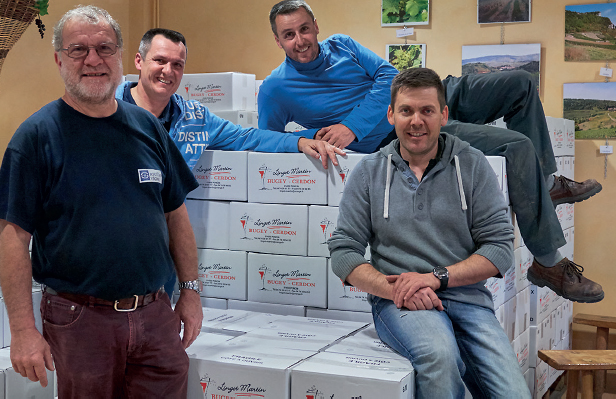
The partners of Lingot-Martin; Jean-Luc Guillon is second from left.
As far as I know, this is the only producer that offers four different Cerdon cuvées, all distinctly different and of a very good standard. In tasting order, first up is the Sec (rather than the usual demi-sec), with just 22g/l of residual sugar and 9% alcohol (more than usual because the fermentation is allowed to continue longer) – its lower sugar level makes this Gamay fizz versatile with food, and it is growing in popularity. The Classic represents 60% of production and is a simple red fruit semi-sweet Gamay fizz, of very consistent, decent quality. Sélectionnée had 70% Poulsard in the blend until the 2016 vintage, when they used 90% Poulsard. This level means it is considerably paler (only the Gamay is macerated), it has a finer bubble and is a more vinous, structured wine, but it needs drinking even earlier than the others. Finally the darker pink-red Cuvée Réservée is a more intense Gamay that has been through a longer maceration and is bottled later. With its hint of tannin I like this too – it’s hard to choose.
This serious and efficiently run estate is an asset to the appellation. Mechanization in the vineyards (50% machine harvested) and in the winery is essential here, they explain. They try to work their vineyards in a sustainable manner, but declare that converting to organics is too difficult. Fermentation is with cultured yeasts at the start, but then they let the indigenous ones take over as they work better with the very low temperatures. All is bottled by the end of November.
There’s a good team here, which helps, because the main driver of the company, Jean-Luc Guillon, is often busy with the syndicate. As vice-president he had spearheaded the region’s fight against Clairette de Die rosé. As president, he is continuing the fight, but I hope that one day when the legal case is over Jean-Luc will put the same energy into raising quality standards even further and bringing the message to the world about the potential quality of this appellation and of Lingot-Martin as an excellent representative.
Cellier Lingot-Martin
ZA Sous la Côte Ménestruel, 01450 Poncin
Tel: 04 74 39 97 77
Email: lingot-martin.isa@orange.fr
Web: lingot-martin.fr
Contact: Jean-Luc Guillon
Map ref: B2
Vineyards: 40ha (including 4.5ha Poulsard) and some purchased
Visits: Tasting room
Domaine Renardat-Fâche
With sales in around 12 countries, this is the most internationally recognized Cerdon label and the wines are a wonderful ambassador for the region. In a determined and motivated way, the current generation of wine-growers here, Elie and Christelle Renardat-Fâche, have built on what Elie’s father Alain had established and he, in his day, built on what his father Léon had created. Several generations prior to Léon were mixed farmers with vines in Cerdon. Léon had fruit and nut orchards and a few cows, but mainly he farmed his Gamay vines to make some sparkling and some rather hard (says Alain) still red. Sparkling Gamay was what he wanted to perfect and he was one of the region’s pioneers, taking time to visit Champagne, Die, Gaillac and elsewhere to see what he could learn. In 1974, when Alain officially joined the estate after wine studies in Beaune, Léon and Alain installed temperature-controlled tanks – the first in the region. At the time the family had just 2.5ha of vineyards. ‘We are almost bottling grapes here,’ says Alain Renardat-Fâche and he makes it sound easy, but much effort goes into making their Cerdon.
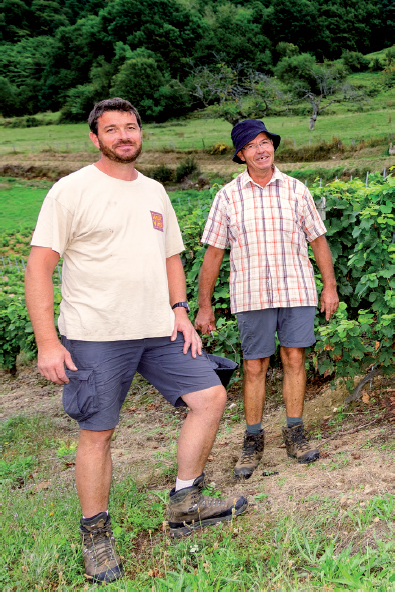
Elie and his father Alain Renardat-Fâche during harvest.
Elie also studied in Beaune and joined his father in 1996, by which time the estate had 8ha. Alongside Elie, Christelle helps in most aspects of the domaine, especially for tastings and sales, and is a great educator for the region. Alain’s wife Mireille is also still involved. The Poulsard grape is a passion for Elie and Christelle, for they believe it gives a finer and creamier edge to the wine, as well as better structure. From 2008 they started official organic conversion, with full certification in 2012; however, they note that their treatments changed little. The biggest change was buying better equipment to be able to plough and mechanically weed their steepest slopes. Elie is testing certain aspects of biodynamic farming, mainly using plant sprays and experimenting with biodynamic preparations. He is not yet convinced to go all the way with biodynamics and says that farming organically remains very difficult, given the amount of rain they receive, and they find it hard to keep within the limits for copper usage. In addition to their own production, about 15–20% extra is purchased from small local vineyards. Since 2015 they’ve started using their own picking team to harvest the purchased fruit so that they can control selection at the vine, usually picking earlier than at their own vineyards. They are meticulous in keeping everything separate.
Renardat-Fâche’s Cerdon with the pale grey label is the négociant one and these days is 100% Gamay from both purchased fruit and also fruit from their young vineyards or those in conversion to organics. It’s the first wine to be bottled and the first to be transferred. The black label adorns the delicious organic estate wine: with 30% Poulsard, it has 50–60g/l of residual sugar and 8–8.5% alcohol and shows excellent balance. As well as different labels, the wines have different coloured capsules for better traceability.
In most vintages, the last picking bins of the day are destemmed and then macerated for a few hours to obtain the colour, while the rest are left as whole bunches and directly pressed. For some time Elie has used only indigenous yeasts. Also very important for him is to keep the bottles standing up so that the fermentation restarts slowly, which gives a finer bubble.
The family have always made a little Gamay still red wine for their personal consumption; from 2016, they have made a few thousand bottles to sell, using destemmed grapes, fermented at very low temperature with one pump-over daily, then pressed after three weeks. I have not had the chance to taste it, but Elie says it is a low-alcohol fruity Gamay with the structure of a Mondeuse – interesting! It might raise some eyebrows locally, in this ultra-traditional area, but the family have a history of that. Without doubt, they are wonderful world ambassadors for Cerdon and for Bugey.
Domaine Renardat-Fâche
115 Rue de la Balmette, 01450 Mérignat
Tel: 04 74 39 97 19
Email: contact@renardat-fache.com
Web: renardat-fache.com
Contact: Christelle Renardat-Fâche
Map ref: C2
Vineyards: 12.5ha (including 3ha Poulsard) + some purchased fruit
Certification: Ecocert
Visits: Tasting room, preferably by appointment
Rondeau-Guinet
Bernard Rondeau comes from the Loire Valley, the son of a farmer in Anjou who kept dairy cows. Bernard decided on a career in wine and studied in Bordeaux before returning home for his practical experience with Anjou vigneron Olivier Cousin and then working with the Daviau family at Domaine Bablut. Growing up in Anjou Rosé country, he was obviously drawn to all wines pink. Marjorie Guinet hails from a farming family of the Cerdon area, in the hidden hamlet of Cornelle, part of the small village of Boyeux-St-Jerôme. Until the late 1990s the Guinet family lived from apple orchards and a few parcels of Gamay vineyards, from which they made a sparkling (carbonated) Cerdon. Marjorie wanted to continue the family tradition and went to Mâcon for wine studies. Along the way she met Bernard and enticed him to move east; the pair took on the family estate, converting it entirely to wine production in 1998.
They have six vineyard parcels, mostly in Boyeux and among the highest in the region, at between 450 and 500m. Bernard describes the terroir as being stonier than Mérignat, but similar in that it has more clay than Cerdon. He says that working the soil is not practical due to the uneven nature of the land, but he has grassed down all the vineyards and works with a small tracked vehicle, using herbicide below the rows. He believes that machine harvesting damages the grass, so harvests manually.
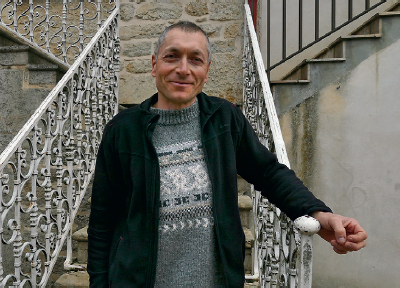
Bernard Rondeau.
When the couple started, they had to invest in new equipment for everything; Bernard likes a squeaky-clean cellar and finds that natural yeasts take too long to get fermentation started, so he starts with a cultured yeast and then lets the natural ones take over. After bottling he leaves the bottles standing upright for longer than the statutory two months if possible. He does at least 12 transfer operations each year on the premises, with the wine remaining in pressure tanks overnight. He encourages his French wine shop clients to take small quantities often and even Charles Neal, his California importer, ships three orders per year.
Bernard makes a Bugey Brut, using a Jura service to undertake the traditional method, and three still wines, but his main product is the Bugey Cerdon, with about 10% Poulsard. The singularity of this wine is that, along with Lingot-Martin’s Sec cuvée, it is one of the driest in the area with about 35g/l of residual sugar at most, reducing through the year with each batch. It has a pretty pale colour and a vibrant strawberry nose, and is a style suited more as an aperitif rather than after a meal. This is a quietly meticulous winery.
Rondeau-Guinet
7 Rue des Vignerons, Cornelle, 01640 Boyeux-St-Jérôme
Tel: 04 74 37 12 34
Email: bernard.rondeau01@orange.fr
Web: bugey-cerdon-rondeau.fr
Contact: Bernard Rondeau
Map ref: C1
Vineyards: 9ha
Visits: Tasting room, preferably by appointment
Vucher & Fils
The Vucher family is entrenched in Cerdon history. In the tank room, Eric Vucher explained to me that this was once a carpenter’s workshop, where in the Second World War his grandfather, Jean-Baptiste Vucher, hid from the Germans when they came to arrest resistance supporters. There are many grim wartime stories of Cerdon and its surroundings – there is a resistance memorial just outside the village. Eric’s father Georges Vucher, who officially founded the estate, is also something of a local hero. In the early 1970s a violent storm provoked a huge earth slippage from the steep vineyard slope above the village, and caused major damage to some of the houses. To prevent a recurrence Georges developed the system of channels to drain the water that is still in place today. Jean-Baptiste Vucher had been a mixed farmer and Georges began the wine estate in 1974 while working for a local wine négociant, which is no longer in business. When Eric joined his father 20 years later, they had 3.5ha and took on another hectare right away. Now, from nearly triple the area, Eric makes just over 100,000 bottles, including a tiny amount of carbonated wine from Gamay de Bouze and some traditional method Bugey Brut from Chardonnay. As well as the estate Bugey Cerdon, he also makes a further 30,000–50,000 bottles from purchased juice, which is sold separately.
The vineyard holdings include an old parcel of Gobelet-trained vines, located on the steep southeast-facing slope above the village – it ripens two days ahead of all their other vineyards and has to be hand-harvested, unlike the rest. Eric explained that this old vineyard is weed-killed 100% chemically, whereas the other vineyards are grassed-down and mechanizable, with herbicide used only below the vine rows.
The tasting room is in an early 18th-century village house, purchased by Georges, who still works in the vineyards part time. It’s an atmospheric place to taste their estate Cerdon cuvée. From almost 100% Gamay, it’s different every year, and Eric tells me he blends it on the basis of the smell. Much is sold from the tasting room and at wine shows, but they have good markets beyond too. And Eric is beginning to think big now that he’s found an importer in Texas.
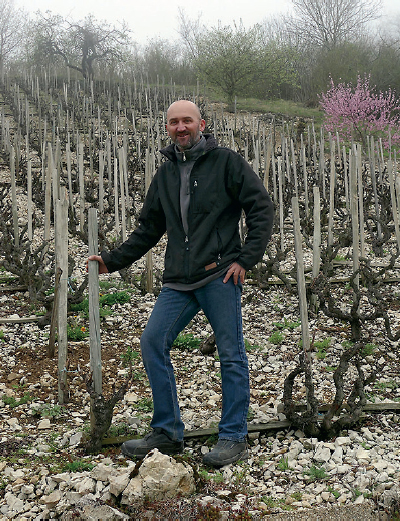
Eric Vucher with his Gobelet-trained vines on the limestone scree of Cerdon’s La Grande Côte.
Vucher & Fils
38 Cour de Tâche, La Suisse, 01450 Cerdon
Tel: 04 74 39 96 61/06 08 75 92 19
Email: contact@cave-vucher.fr
Web: cave-vin-cerdon-vucher.fr
Contact: Eric Vucher
Map ref: C2
Vineyards: 11ha (+ some purchased grapes)
Visits: Tasting room, visits welcomed, preferably by appointment